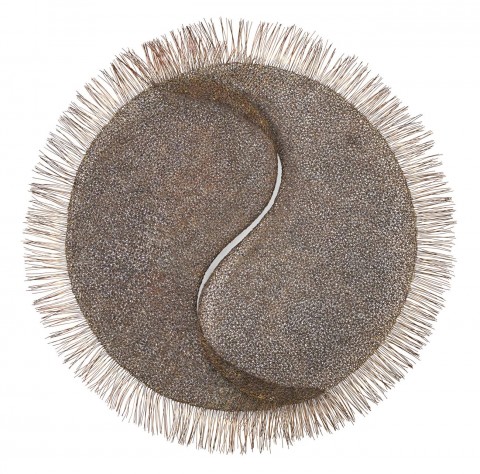UNITY, 2001
BRONWYN OLIVER
copper
112.0 cm diameter
Roslyn Oxley9 Gallery, Sydney
Private collection, Sydney
Deutscher and Hackett, Sydney, 1 September 2010, lot 6
Private collection, Melbourne
Bronwyn Oliver, Christine Abrahams Gallery, Melbourne, 24 November – 21 December 2001 (illus. in exhibition catalogue)
The Sculpture of Bronwyn Oliver, Tarrawarra Museum of Art, Victoria, 19 November 2016 – 5 February 2017
Fink, H., Bronwyn Oliver: Strange Things, Piper Press, Sydney, 2017, pp. 158 (illus.), 212 – 213 (illus. installation), 220
McDonald, J., ‘Arts’, Sydney Morning Herald, Sydney, 10 January 2017
‘...Bronwyn Oliver had that rarest of all skills: she knew how to create beauty... Her art was fully resolved - perfect, really - and she stands alone in the annals of Australian art history. There was no-one like her: she invented her own deeply intelligent form, and entered fully into the world that it opened out to her...’1
One of Australia's most highly regarded contemporary sculptors, Bronwyn Oliver remains celebrated for her extraordinary ability to produce meticulously articulated works of immense beauty and grace which unite timeless, organic forms of the natural world with the abstract logic of geometry. Simple yet complicated, fragile yet strong, eccentric though at the same time oddly straightforward, her delicately woven copper and bronze assemblages such as Unity, 2001 universally surprise and inspire – beguiling both the eye and mind through their enigmatic presence. With their tactility and anatomical physicality, such intricately executed forms moreover inevitably elicit a temptation to touch - the sensual, prehistorically-scaled versions of natural phenomena thus reminding us that the world is a corporeal place.
Yet too often the easy, voluptuous curves of Oliver's objects belie the punishing, labour-intensive process to which the artist was so passionately committed. Inspired by the patina of age and veneration shared by ancient relics and humble artefacts, Oliver would painstakingly manipulate dizzying twistings and welds of pliant copper wire to create the ‘weave’ – the microstructure of her organic sculptural forms which gradually became more open and geometric to allow light to permeate and exaggerate their optical aspect. ‘Bronwyn’s sculpture belongs to a genealogy of female art: to the open grids of Agnes Martin, the looping, webbed and netted painted surfaces of Emily Kngwarreye and Yayoi Kusama, the undulating fields of Bridget Riley and Rosalie Gascoigne – works of art which occur in Julia Kristeva’s ‘Women’s Time’: fluid, cyclic, edgeless, eternal.2
As Amanda Rowell muses in her introduction to Oliver's exhibition at Roslyn Oxley Gallery in September 2004, ‘...the microcosmic, complex surface of an Oliver sculpture is an interface between the macroform of its overall shape and the internal cavity or void where the sculpture breathes. The ease of connection between these three formal aspects of her works, along with their gently mimetic character - as alluded by their titles - constitute their elegance and simple pleasure...’3
1. Fink, H., Bronwyn Oliver (1959 - 2006), Obituary, Roslyn Oxley9 Gallery, Sydney, 10 July 2006, see http://www.roslynoxley9.com.au/news/releases/2006/07/10/112/
2. Fink, H., Bronwyn Oliver: Strange Things, Piper Press, Sydney, 2017, p. 207
3. Bronwyn Oliver 2004, 9 September 2004, see http://www.roslynoxley9.com.au/news/releases/2004/09/08/80/
VERONICA ANGELATOS
